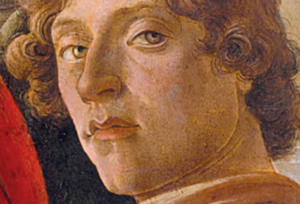 Sandro Botticelli (whose full name was Alessandro di Mariano di Vanni Filipepi) was a painter of the early Renaissance. Born in Florence around 1455, he worked under the patronage of Lorenzo de’ Medici, a member of a very powerful and wealthy family in Florence. Known also as Lorenzo the Magnificent, Lorenzo lived in the Golden Age of Florence, an age with which his death effectively coincided. As well as patronizing many lesser-known poets, artists, and scholars, alongside Botticelli, Lorenzo’s most famous sponsor was Michelangelo himself.
Sandro Botticelli (whose full name was Alessandro di Mariano di Vanni Filipepi) was a painter of the early Renaissance. Born in Florence around 1455, he worked under the patronage of Lorenzo de’ Medici, a member of a very powerful and wealthy family in Florence. Known also as Lorenzo the Magnificent, Lorenzo lived in the Golden Age of Florence, an age with which his death effectively coincided. As well as patronizing many lesser-known poets, artists, and scholars, alongside Botticelli, Lorenzo’s most famous sponsor was Michelangelo himself.
Though Michelangelo might be more of a household name that Botticelli, I can guarantee you’ve seen a number of Botticelli’s paintings. We owe the masterful beauty of The Birth of Venus to him, as well as the glorious Primavera. That said, don’t worry if you’re not familiar with these pieces; that’s why you’re reading this blog! By the end of your time here, you’ll be well-acquainted with the most famous of Botticelli’s works, as well as some lesser-known pieces that are, frankly, equally as stunning. Unfortunately, Botticelli’s work was enormously under-appreciated in the time directly following his death, and was not again considered worthy of much study until the late 19th century.
This decline in the popularity of his work could possibly be attributed to the popularity in the 1490s of a reformist Dominican priest called Savonarola. Savonarola was a very strict fellow, and would not rest until all secular art was destroyed and there was a renewal of the church. He condemned the behaviour of the Medicis, claiming that their patronage of the arts and extravagant lifestyle was sinful and damning. Though Botticelli was close to Lorenzo de’ Medici, he was a devoted followed of Savonarola. In 1497, the monk held the Bonfire of the Vanities, which was literally a huge bonfire into which he demanded all secular or pagan objects be destroyed, including many books and pieces of art. Countless masterpieces were very likely lost to this infamous blaze, and though it’s not known for certain, some claim that some of Botticelli’s pagan works were among those lost to the inferno.
Likely thanks to Botticelli’s admiration of Savonarola, a great change in his art can be seen beginning in the early 1490s. Not only does his style change, but he seems to have worked exclusively on religious works, and took a great interest in creating illustrations to accompany the printed edition of Dante’s Divine Comedy. There is debate among scholars as to whether Botticelli produced much work after he was so drastically influenced by Savonarola. Certainly, it seems that he was without many commissions after the deposition of the Medicis, and that this may have contributed to waning health. Botticelli passed away in 1510, and was buried in the Church of Ognissanti, at the feet of one Simonetta Vespicci, for whom it is believed that he may have harboured a fierce but unrequited love. This woman seems to be depicted in many of his works, and is thought to perhaps even have been the model for Botticelli’s famous Venus.